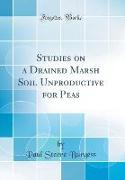Studies on a Drained Marsh Soil Unproductive for Peas (Classic Reprint)
BücherAngebote / Angebote:
Excerpt from Studies on a Drained Marsh Soil Unproductive for PeasSeptember 3, 1919: First samples drawn. Plots staked out but no fertilizers yet applied.November 3, 1919: First sampling since planting. As less than of an inch of rain had fallen since planting, but few of the seeds had sprouted.January 20, 1920: The peas were 2 to 3 inches high and a good stand had been secured. Over 4 inches of rain had fallen since last sampling, but the nights were cold (often below freezing), and the days were usually cloudy and cold.February 21, 1920: Less than one inch of rain had fallen since January 20. The Soil was very dry (moisture determinations showed but 27% in the surface soil and 42% in the subsoil). The plants had grown but an inch or two during the month and were often more or less wilted during the middle of the day. The nights were cold. Poor conditions for growth. There was no difi-erence between the checks and the phosphate-treated plots.March 27, 1920: 'the plants were looking well. About 3 inches of rain had fallen since last sampling. The vines on the check plots were 6 to 8 inches high while those on the phosphate-treated plots were 10 to 12 inches high. The lime-treated plots showed no improvement over the checks.April 26, 1920: The plants were looking fairly well, although little rain had been recorded during the month past. The vines were covered with blossoms and filling pods. There was a noticeable difference in favor of phosphate-treated plots although the lime-treated plots showed no gain.May 24, 1920: Peas about ready to cut. Vines turning yellow, pods well filled and dry. The soil had dried out and was very parched and hard. This was the last date of sampling.About the PublisherForgotten Books publishes hundreds of thousands of rare and classic books. Find more at www.forgottenbooks.comThis book is a reproduction of an important historical work. Forgotten Books uses state-of-the-art technology to digitally reconstruct the work, preserving the original format whilst repairing imperfections present in the aged copy. In rare cases, an imperfection in the original, such as a blemish or missing page, may be replicated in our edition. We do, however, repair the vast majority of imperfections successfully, any imperfections that remain are intentionally left to preserve the state of such historical works.
Folgt in ca. 10 Arbeitstagen




